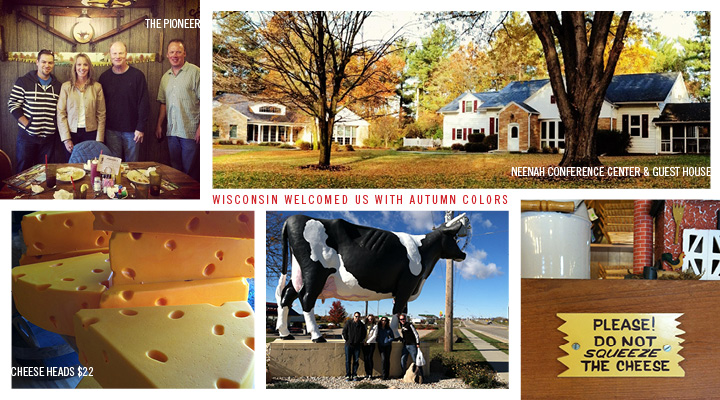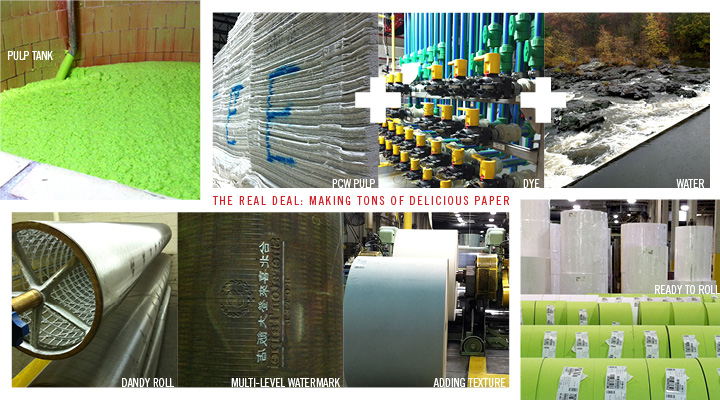A rare adventure in our industry these days is The Mill Trip. I’d been on one back in the day, when I was just starting my career in Chicago. That trip was to a coated mill producing white paper, so I nearly went off the deckled edge when I was invited by Debbie of xpedx and Randy of Neenah Paper to travel to Wisconsin on October 8th. Completing the entourage were print designers Jeff of Cultivator and Jorge of Cactus, two print designers as passionate as I about paper and its potential.
And so with carry-ons in hand at Gate B90, the designer geekfest was officially underway.
 Our drive from Madison to Steven’s Point was a trip down memory lane for me, as it was the same route I’d driven countless times to a family cabin when living in Chicago. The flat, open landscape with light blue sky and long clouds reminded me of growing up in Illinois. But it wasn’t long before things got exciting. First Jeff piped up from the ‘way back’ of the van, “I think I just saw a roll-over.” Sure enough, a minivan has swerved off the other side of the highway into the wide, grassy median, hitting a small pine tree before coming to rest upside down on it’s windshield. Every car on the highway stopped to help. The driver and her daughter were fine, so we continued along until we came upon “The Pioneer”—your typical mid-western roadside diner. An hour after polishing off only half of the “small” open-faced turkey platters and admiring the painted saws around the room, we found ourselves at the exit for Steven’s Point, home of The Whiting Mill.
Our drive from Madison to Steven’s Point was a trip down memory lane for me, as it was the same route I’d driven countless times to a family cabin when living in Chicago. The flat, open landscape with light blue sky and long clouds reminded me of growing up in Illinois. But it wasn’t long before things got exciting. First Jeff piped up from the ‘way back’ of the van, “I think I just saw a roll-over.” Sure enough, a minivan has swerved off the other side of the highway into the wide, grassy median, hitting a small pine tree before coming to rest upside down on it’s windshield. Every car on the highway stopped to help. The driver and her daughter were fine, so we continued along until we came upon “The Pioneer”—your typical mid-western roadside diner. An hour after polishing off only half of the “small” open-faced turkey platters and admiring the painted saws around the room, we found ourselves at the exit for Steven’s Point, home of The Whiting Mill.
The Whiting Mill opened in the late 1800s on more than 300 acres of forested land along the Wisconsin river. Most of the acreage has remained untouched, covered in burgundy oaks, orange maples, and golden birch trees. Neenah makes many of its uncoated Text and Cover papers there, including the popular Classic Crest and Classic Linen grades. Astrobrights’ Terra Green was being made during our visit. The bright green pulp had a Willy Wonka quality about it that made for excellent viewing!
We started our tour at the Neenah conference center, participating in an informal focus group lead by Kathy and Chris. The topic was Neenah’s Environment line. What do we use? What do we like? What would we do differently? Being full of opinions, I was happy to contribute to the discussion.
Next we arrived at the Mill where Jason greeted us and took us through R&D showing us, in miniature, how paper is made. We each started with some post-consumer waste pulp and added our choice of sprinkles. I chose blue flecks and white sparkles. Next, this was mixed with a lot of water, poured into container that drained the water, leaving only the fibers in an evenly distributed sheet. That then was pressed to remove more water and placed in a dryer. Ta da! Helen’s “Blue Lagoon.” This process was repeated for each of us. Jorge named his chunky orange fleck with peachy copper background “Liver Spots.” I’m not sure Neenah will be adding these masterpieces into their Text and Cover line anytime soon, but the process of making my 9x9 inch sheet is the same when making a roll that’s 100-inches wide and 2500 pounds. Precise measurement is all it takes to extrapolate ounces into tons.
After an overview of the mill’s history and the basics of paper making, we donned headphones and safety glasses to tour the mill. Jason introduced us first to the pulping machines, giant vats that mix precise proportions of post-consumer waste and reclaimed virgin paper scraps with water. Dye is added at this point, if it’s a colored sheet.
This pulp, now 90% water, is pumped into a three-story-deep holding tank where it then moves into the paper-making machine. The mixture floods a giant horizontal mesh screen that agitates so the fibers evenly distribute into a flat sheet, releasing water to be recycled back into the pulping machines. This flat fiber sheet, now 60% water, feeds into driers, a long series of large and small cylindrical steam-heated rollers. Steam is rising all along the giant machine-—about the size of a semi-truck—and the whole room feels humid and warm. At the end of the drier, the paper is sometimes coated with sizing and rolled up on a core. This roll is 100 inches wide and weighs 2500 pounds. They aren’t messing around.
The finishing process varies. Unlike the coated mill that calendared each sheet, these uncoated sheets are often textured. Some of the textures are created during the creation of the sheet (Esse) and others are added later (Classic Linen). If a stationery sheet is being made, a dandy roll might be added to create a watermark. A company logo is hand-soldered onto a mesh roll that then pushes into the fibers. This happens during the sheet making. After the paper is done, the roll is removed and quality checked. Then it’s cut into smaller rolls and textured, sheeted or shipped as is. If it doesn’t pass Neenah’s high standards, the roll is recycled—back into the pulper.
Although paper making is basically the combination of pulp, water and heat, a lot of science goes into each sheet. Much of the mill staff is composed of engineers—chemical, mechanical, electrical and civil. The precision needed to produce a paper of this quality and quantity is, indeed, impressive. Details of each grade’s texture, color, formation and weight were dialed in on computers and monitored by skilled workers. Each employee we encountered was passionate about making paper. I never thought I’d meet anyone who cared about paper as much as print designers like me.
But at Neenah Paper, paper nerds rule!
—Helen
Photos by Jorge Lamora and Helen Young





